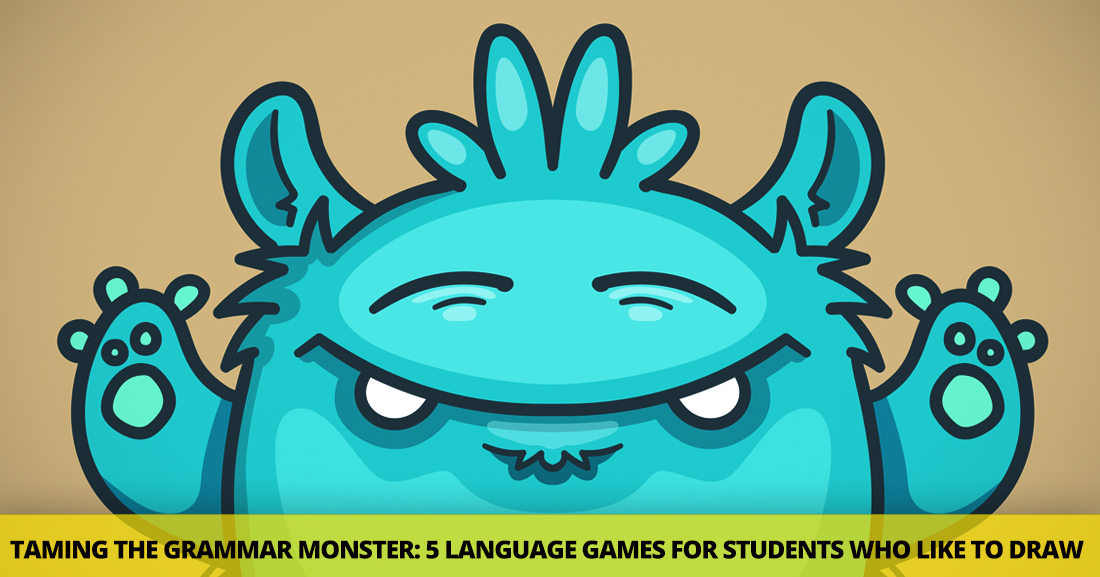Taming the Grammar Monster: 5 Fun Language Games for Students Who Like to Draw


We can sort adjectives into several different categories one of them being possessive adjectives - ones that show ownership. There are lots of ways to practicing using possessive adjectives in class. What I’ve put together here are some fun and out of the ordinary games you can use to practice using possessive adjectives with your ESL students.
This game isn’t for every class, but if yours is fun-loving, they will enjoy this out of the box way to practice possessive adjectives. Have everyone in class remove their shoes and put them in a pile in the center of the room. Mix them up a little bit, and then direct each student to choose two shoes that do not belong to them. Once everyone has two shoes, let them mingle asking their classmates, “Is this your shoe?” and answering the questions. If there is not a match between the shoe and the person, that person should make a suggestion as to whose shoe it might be. “I think that shoe might be hers.” Or “I think that might be his shoe.” If a shoe does belong to the person being asked, they take it back and either put it on their foot or set it aside until the game is over.
If you don’t want to have students remove their shoes, and some students will be very happy they don’t have to, you can do the activity by having students put their pencils in a pile, numbered Popsicle sticks, flash cards, or anything else you happen to have on hand or students have with them. Just make sure students will be able to tell which one is theirs (i.e. don’t use pencils if everyone has the same yellow number two pencil).
They say that people choose dogs that look like them. You can use this fun premise for a matching game in class that practices possessive adjectives. Start by gathering several pictures of people who look like their dogs. A simple Google search on people who look like their dogs will turn up many options for you to choose from. Then separate the pictures of human and dog, mix them up, and make copies for your students. Have students work with one partner, and give each pair a set of the pictures. Have students cut out the pictures and then work together to match each human with their dog. As students make their matches, encourage them to use possessive adjectives when talking about which dog belongs to which person.
I love to play Win, Lose, or Draw for practicing vocabulary words, but you can also use this lively game to practice possessive adjectives. Put a selection celebrity names in a hat. They do not have to be real people though they can be. Cartoon characters such as Mickey Mouse work well, too. Divide your class into two teams. Have one person from each team come to the board and let one of them draw a celebrity from the hat. On your go, the two players race to draw a picture of the person on the slip of paper while their team guesses who it is. In order for a guess to count, the players must start it with a phrase such as “His/her/its name is…” Give the artists two or three minutes to draw for their team before calling time. Award a point to any team that guesses the person correctly.
How creative can your students be? Have them work with a partner to draw their own composite drawings. Start by gathering several pictures of people and animals. It is easiest if you make copies of all the faces for every pair of students in class. Once students have copies of the pictures, they should get ready to draw. Reassure students that they will not be graded on the quality of their drawings, but they should try to make them look as good as they can. Then one person chooses three or four elements from different pictures that they would like to see made into a composite drawing. For example, a student might say, “I want his face, its tail, her hair, and their feet.” The other person should then do their best to put the pieces together as their partner has requested. Once finished, they should show their drawing to their partner. Then students switch roles. After both people have drawn a composite picture, switch partners. Now each person should look at the picture their new partner drew and try and guess which parts came from which pictures. For example, someone might say, “I think that is his nose, her feet, their eyes, and its body.” If you like, have these partners instruct each other on what to draw and then switch again to see if their classmates can guess what parts made up the picture.
You’ll want your students to pull out their smart phones for this fun and sneaky picture taking activity. Have each person go around the room and take some sneaky pictures of items that are not so obvious. Someone might take a picture of a friend’s shoelaces, a text book, a fingernail, etc. Students should try to take their pictures without letting anyone see what they are snapping photos of. Then have students email their photos to you or use them directly from your students’ phones. Show a picture to the class and have them guess who the items belongs to. They might say, “That’s your shoe.” Or “It’s my textbook.” It’s up to you whether you let all of your student guess at once or if you would like them to take turns.
Try these games with your class when it’s time to review possessive adjectives, and they will have the time of their lives. You can rest assured that they will also learn.